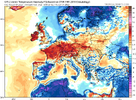SOLAR CYCLE 25 ACTIVITY REPORT MAY 24_2023
Solar activity has been at moderate levels for the past 24 hours. The largest solar event of the period was a M3 event observed at 1213 UTC from Region 3311 (N18E05) it caused a Minor R1 radio blackout over North Africa and Europe.
There are currently 5 numbered sunspot regions on the solar disk: AR3310, AR3311 AR3312, AR3313 and new region AR3315,
AR3308 and AR3314 are gone.

Total number of sunspots remains at 97 (69 of these are grouped into 5 active regions) NOAA forecasts for the next 24h: 99% chance for C flares, 60% chance for M flares and 20% chance for X flares. Sunspot AR3311 has a beta-gamma-delta-class magnetic field that harbors energy for X-class solar flares.
● Auroral Activity
The geomagnetic field has been at quiet to active levels for the past 24 hours. Solar wind speed reached a peak of 626 km/s (Moderately high speed) at 02:57 UTC on May 23. Active geomagnetic conditions (Kp4) threshold reached at 22:58 UTC
Aurora Oval Bz: 0.98 nT North

● Current Conditions at 03:20 UTC on May 24
▪︎ Geospace unsettled (kp 3)
▪︎ Solar wind speed record: 578.7 km/sec (Moderately high speed)
▪︎ density: 1.11 p/cm³ (low density)
▪︎ Neutron Counts today: -0.6% (below average)
▪︎ X-ray Solar Flare: C3 at 21:18 UTC
▪︎ Sunspot number: 97 (SN 97 May 23)
▪︎ Spotless Days 2023 total: 0 days (0%)
SpaceWeatherlive..com
SpaceWeather.com
Solar activity has been at moderate levels for the past 24 hours. The largest solar event of the period was a M3 event observed at 1213 UTC from Region 3311 (N18E05) it caused a Minor R1 radio blackout over North Africa and Europe.
There are currently 5 numbered sunspot regions on the solar disk: AR3310, AR3311 AR3312, AR3313 and new region AR3315,
AR3308 and AR3314 are gone.
Total number of sunspots remains at 97 (69 of these are grouped into 5 active regions) NOAA forecasts for the next 24h: 99% chance for C flares, 60% chance for M flares and 20% chance for X flares. Sunspot AR3311 has a beta-gamma-delta-class magnetic field that harbors energy for X-class solar flares.
SUBSIDING CHANCE OF FLARES: NOAA forecasters have decreased the odds of an X-class flare from 30% (yesterday) to 20% (today). This is in response to decay in the magnetic field of sunspot AR3311, currently the biggest threat for flares on the solar disk. 20% is still plenty, though, for an X-class explosion. SpaceWeather.com
● Auroral Activity
The geomagnetic field has been at quiet to active levels for the past 24 hours. Solar wind speed reached a peak of 626 km/s (Moderately high speed) at 02:57 UTC on May 23. Active geomagnetic conditions (Kp4) threshold reached at 22:58 UTC
Aurora Oval Bz: 0.98 nT North
● Current Conditions at 03:20 UTC on May 24
▪︎ Geospace unsettled (kp 3)
▪︎ Solar wind speed record: 578.7 km/sec (Moderately high speed)
▪︎ density: 1.11 p/cm³ (low density)
▪︎ Neutron Counts today: -0.6% (below average)
▪︎ X-ray Solar Flare: C3 at 21:18 UTC
▪︎ Sunspot number: 97 (SN 97 May 23)
▪︎ Spotless Days 2023 total: 0 days (0%)
SpaceWeatherlive..com
SpaceWeather.com







